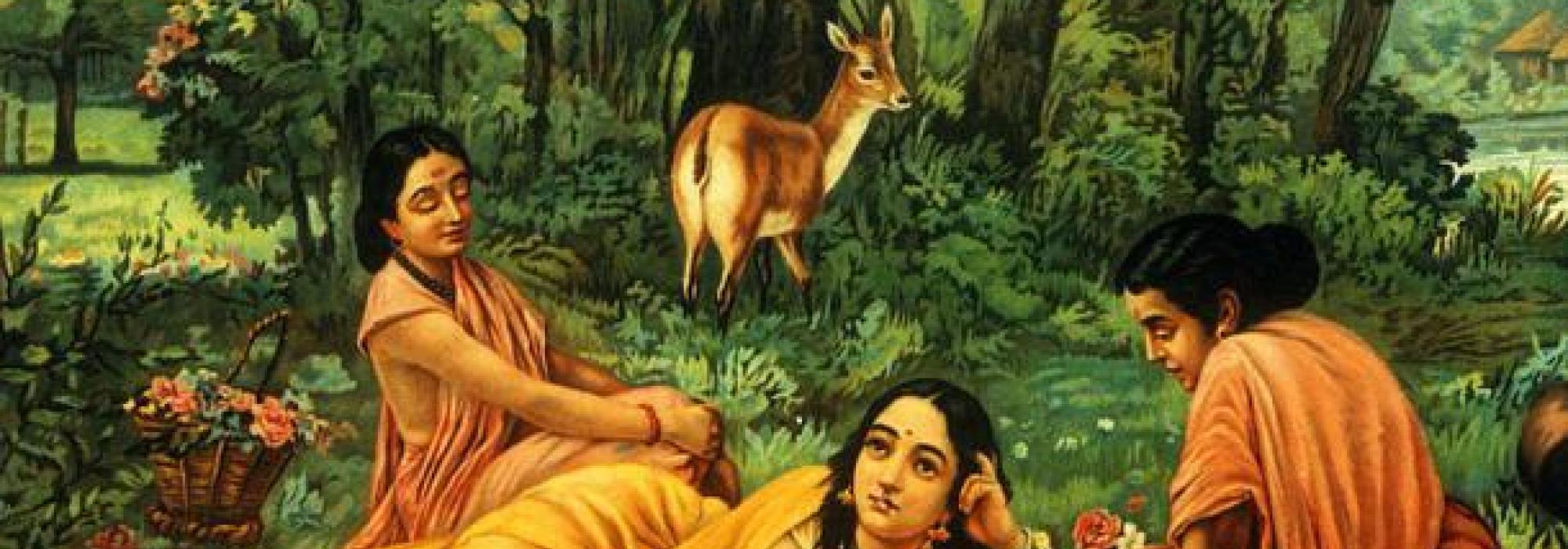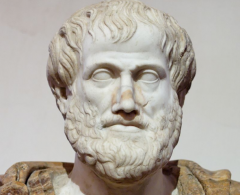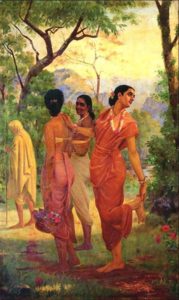Abstract:
The current article attempts to examine where the Indian play Abhijñāna-Śākuntalam, considered to be the best by both the lay and the learned, by oriental and occidental aestheticians, stands when examined using the parameters of literary aesthetics that evolved in a different culture, albeit a kindred one, ancient Greece, a sister civilization of India. It does this by trying to examine the play through Aristotle’s eyes, using the literary yardsticks that he has set in his Poetics. Subsequent to this analysis, it will be shown that the play Abhijñāna-Śākuntalam (hereafter referred as ‘Śākuntalam’) emerges as the best, even with these yardsticks. Certainly there are several features that make Śākuntalam great, but all of these will not be discussed in this article, as they do not fall the framework defined by Aristotle and hence would go well beyond the scope of this article. Nor is the article an attempt to evaluate the merits of Aristotle’s yardsticks; it merely applies his definitions to analyse the play. Thus, the contribution of the article lies in the fact that it uses a highly acclaimed theory of Western literary aesthetics to analyse what is generally held to be the contribution of a great Indian poet, Kālidāsa, in his best play, the Śākuntalam.
(The translation of all the Sanskrit phrases and verses quoted in the text are the author’s and so are a few Greek phrases; the rest are by Stephen Halliwell [1]. The original Sanskrit text of the play Abhijñāna-Śākuntalam is from [2])
Introduction:
Aristotle was a Greek philosopher and aesthetician who lived in the 4th century BC. His Poetics is the earliest available treatise on literary aesthetics and dramaturgy in the West. It is the first work to discuss and analyse poetry as an art, and has laid the foundation for an entire tradition of literary theory and criticism. Stephen Halliwell observes the potential reasons why a philosopher like Aristotle might have taken an interest in and concerned himself with poetry – “the first, a response to poetry’s vital, long established importance within Greek culture and education and its consequent interest for a philosopher widely concerned with the forces influencing
the life and mind of his society…..” [1]. Poetry was accorded an important position in India, too, and like with any evolved culture, life and poetry are reflections of each other. Thus, Aristotle’s motivation in writing the work has a universal basis.
One of the main features of Aristotle’s work is that it is an explicit attempt to scrutinize poetry in a systematic and analytic manner by defining terms, providing examples and counter-examples to establish an aesthetic theory and thereby trying to make the connections between its basic tenets and definitions as tight as possible [1]. A second salient feature, identified by Stephen Halliwell, is that Aristotle is not blind to the history of poetry and that history is indispensable to the interpretation of certain conventions and possibilities of poetic practice. This is true in the Indian scenario too, as there are certain poetic conventions that have been set by tradition (such as the things that are deemed suitable for depiction on stage), and followed historically, which warrant a willing suspension of disbelief. Although the literary history of Greece that was discussed by Aristotle is not relevant to the current article, it has played an important role in shaping his definition of the parameters for analysis and evaluation.
Kālidāsa is considered to be one of the greatest Indian poets and he also ranks high in the global scene. His play, the Śākuntalam, is thought to be the fruit of several years of experience as a poet, and is held to be his best by most Indian and western critics. The play comprising seven acts has around eight primary characters and several secondary ones. It revolves around the love story of Duṣyanta, a king, and Śakuntalā, a maiden who was living as a hermit.
The story in brief –
Duṣyanta, who is out hunting in the forest, encounters Śakuntalā in the sage Kaṇva’s āśrama (hermitage). They fall in love and get ‘married’ in the gandharva style. Duṣyanta gives Śakuntalā a ring as a memento – a token of identity and returns to his kingdom. Śakuntalā, who is lost in her romantic thoughts about Duṣyanta forgets her duty to serve the sage Durvāsa who visits the āśrama where she lived. The enraged sage
curses her, ordaining that she would also have to suffer being forgotten by her beloved, in return for her forgetfulness and dereliction of duty. There was, however, a reprieve from the curse, in the form of a token of identity that could revive her beloved’s memory. After a couple of months, Śakuntalā, who is carrying Duṣyanta’s child, is escorted to her husband’s kingdom, only to be rejected by him due to his forgetfulness in fulfilment of the curse. What is more, she has even lost the token that could have secured recognition, namely, the ring, on the way. She is taken away to the sage Mārīca’s hermitage by an invisible person. In the meantime, the king gets to see the ring that was recovered from the belly of a fish by a fisherman. Memories of his beloved Śakuntalā rush back to his mind and he starts lamenting his actions and how he had rejected her when she had come to his court seeking his acceptance and love. He starts pining away for her company, paints her picture and even labours under the illusion that the painted image is the real girl. He is then summoned by the heavens to help vanquish troublesome demons, and on his way back, happens to visit sage Mārīca’s hermitage. There Duṣyanta finds a child who fosters fatherly affection in him and he later discovers that the child is Śākuntala, his son through Śakuntalā. They reunite and the Puru clan to which Duṣyanta belonged finally finds an able successor in Śākuntala, Sarvadamana Bharata.
That was just the narrative, but the way it is structured by Kālidāsa for stage presentation is interesting. The next section analyses the merits of this play using Aristotle’s principles.
Analysis of the play:
Aristotle holds poetry to be more philosophical and elevated than history, since poetry relates more of the universal, while history relates particulars (9:2-6) While history documents the likes of a particular people, poetry deals with the careful delineation of universal human emotions. He even quotes an example of who a real artist is - Sophocles created characters as they ought to be and Euripides as they really are. Thus, Sophocles was more of an artist, as he used the world as a mere spring-board to rise up to sublimity, than Euripides who adhered more to reality. What ought to be is art and what really is, is history documented. The use of a semi-historical or a popular tale, as required by Indian aesthetics as the basis for a nāṭaka, only makes the audience connect better with what is staged. As Aristotle further states, adhering to actual names (and places) makes the possible seem plausible (9:14-15). He adds that it is not the poet’s function to relate actual events, but the kinds of things that might occur and are possible in terms of possibility or necessity (8: 36-40). A poet portrays the kind of things which were or are the case; the kind of things the people say and think; the kind of things that ought to be the case, i.e., the ideal. (25: 1-12). Poetry does not have the same standard of correctness as politics, or as any other art. A poet should be more a maker of plots than of verses (9:22-23). It does not suffice to write verses that are self-contained and beautiful in themselves but they must contribute to a bigger whole, that is sublime.
These views are also in agreement with the Indian view of literary aesthetics and the Indian view goes a step further in delineating the essential aspects of a good piece of literature. Ānandavardhana in his Dhvanyāloka (4.4) and Kuntaka in his Vakroktijīvitam (4.13) respectively say:
दृष्टपूर्वा अपि ह्यर्थाः काव्ये रसपरिग्रहात्।
सर्वे नवा इवाभान्ति मधुमास इव द्रुमाः॥निरन्तररसोद्गारगर्भसन्दर्भनिर्भराः।
गिरः कवीनां स्थास्यन्ति न कथामात्रमाश्रिताः ॥
Although plots and stories that have been viewed previously are being retold by poets again and again, their creative genius gives rise to the experience of Rasa (aesthetic delight), making them seem new at all times. This is due to their artistic delineation of basic human emotions and the aesthetic ornamentation of their works. This timeless quality of works of art is what Indians consider to be ‘classical’.
Tragedy:
The play Śākuntalam, though falls broadly under the category ‘tragedy’ defined by Aristotle, it also has aspects that make it incompatible with his definition in some places. It is definitely not a comedy, as comedy is the mimesis of characters who are baser than men of the world, although not wholly vicious (5: 31-35). The characters of a tragedy are nobler than those seen in the real world and they are idealistic in a sense. To write a tragedy, poets should emulate good portrait painters, who render personal appearance and produce likeness, yet enhance people’s beauty. (16:8-15) SV Ranganna, aptly coins a Sanskrit equivalent to ‘tragedy’, rather than terming it ‘duranta’ (miserable), he terms it ‘gambhīra’ [5], giving it the dimension required by Aristotle - ‘heavy, deep and profound’.
The characters in Śākuntalam are uber-human and noble through their very persona – Duṣyanta, a king of the Puru clan, Śakuntalā, the daughter of a great Kṣatriya-sage called Viśvāmitra and the apsara Menakā, Kaṇva, a sage and so on. They are not common men, but elevated characters, as required by the definitions of a ‘nāṭaka’. In the Indian tradition, art does not remain a mere ‘mimesis’ (imitation) of the world, but is an exalted imitation (bhāvānukīrtanam) of the worldly sentiments. Although Aristotle does not use the words ‘exalted imitation’, his definition of an epic and a tragedy comes close to the Indian view, i.e., “epic matches tragedy to the extent of being mimesis of elevated matters” (6:8-10). The mimesis is of matters, elevated above the worldly level. Śākuntalam ends on a positive note unlike most of the tragedies quoted by Aristotle as example. Aristotle says that tragedy can also go from misfortune to fortune and the best type of tragedy ends happily and is explicitly ranked by him over Oedipus, which ends with great suffering.
In the current analysis, ‘tragedy’ as used by Aristotle will be taken to be a rough equivalent of ‘nāṭaka’ or a ‘play’ in the Indian theatrical tradition.
Epic versus tragedy:
In Aristotle’s view, epic’s resources belong to tragedy (6:19) and many tragedies can be drawn from an epic. He also holds a tragedy as a better piece of art than an epic as greater concentration is more pleasurable (to an audience) than dilution over a long period (26: 15-20). He means that a tragedy, like a single work of a painter, can bring several peaks and crests in emotions and can give its best within a short span of time, thus achieving greater concentration, while an epic, like a series of murals, tends to dilute the concentration and even engenders boredom at times. While this is true, it is debatable if this lone quality warrants placing the tragedy higher than the epic. Just like the epics Iliad and the Odyssey have provided raw material to several plays, the current play under study – Śākuntalam also derives its inspiration from the ‘Śākuntalopākhyānam’ episode of the epic poem Mahabhārata, which was written by the sage-poet Vyāsa. In the current case at least, and true to Aristotle’s words, the version of the story creatively developed by Kālidāsa seems to have caught the hearts of connoisseurs for several centuries and it has even relegated Vyāsa’s original plot to the back seat. Today, when we hear ‘Śākuntalam’, we immediately associate it with Kālidāsa, and it takes us a moment to even recall that the original story was presented by Vyāsa. (This, however, does not mean that Kālidāsa’s play is greater than the Vyāsa’s epic as a whole, but merely shows how an epic serves several purposes). Kālidāsa too observes – “नाट्यं भिन्नरुचेर्जनस्य बहुधाप्येकं समाराधनम्” (Mālavikāgnimitram, 1.5) – A theatrical presentation (of a play) is the sole means of entertainment of the people even though be of varied taste – It caters to the lay and the learned alike.
A.R. Krishna Shastry, in his treatise on Sanskrit plays [3], says “A mythological story (in an epic) is a gold mine. It contains pieces of finest gold but it is blocked by several rugged stones. A playwright attempts to free gold from the stones that block it, extract the best, put them together to give it the shape of an aesthetically sublime image, the nāṭaka (a play)” Thus, the playwright’s job is not merely to extract gold and provide it as a lump to the connoisseur, but to use his imagination to give it an elevated status. Kālidāsa has extracted the best portion of the story from the śākuntalopākhyānam and has added his own creative elements while giving it the shape of a play. Super-natural elements such the curse of Durvāsa, the finger-ring as token of recognition, the recognition of Bharata in Mārīca’s āśrama and the addition of slightly different flavours to the characters of Duṣyanta and Śakuntalā are Kālidāsa’s merits. It will be shown that it is precisely these creative additions of Kālidāsa that make the play great and bring the characters closer to life. Moreover, as will be discussed further, a play must have a few ups and downs, recognitions and reversals to make it interesting within a short span of time. Additionally, it is only fair for a play to have a well-known plot (‘prasiddha-vastu’, as said by Indian aestheticians), as it will take away the burden of suspense from the viewer’s mind and help him appreciate the details. How something is done becomes more important in a work of art than ‘why’ it is done and ‘what’ is done.
References:
[1] Halliwell, Stephen (Edited and translated – 1999), ‘Aristotle-Poetics’, edited and translated by, Loeb Classical Library, Harvard University press
[2] Kale, MR (2005) ‘The Abhijñāna-Śākuntalam of Kālidāsa’ with the commentary of Rāghavabhaṭṭa and translation by M.R. Kale, Motilal Banarsidass Publishers
[3] Krishna Shastry, AR (2012), ‘Samskṛta- nāṭaka’, Hemanta Sahitya – Kannada original
[4] Krishnamoorthy, K (2003), ‘Samskṛta-kāvya’, Vidyuth Prakashana – Kannada original
[5] Ranganna, SV (2014), ‘Pāścātya-gambhīra-nāṭakagaḻu’, Mysore Prasararanga – Kannada original
[6] Stoler Miller, Barbara Ed (1984), ‘Theater of Memory – The plays of Kāḻidāsa’ –, Unesco collection of representative works – Indian series (Original Columbia University Press, 1984)
[7] Karmarkar, RD (1960), ‘Kāḻidāsa’, Karnataka University, Dharawar
[8] Venkataramayya, CK (1966) ‘Kālidāsa-mahākavi’, Sahitya-Samskrti-abhivruddhi-shakhe (1966)
[9] Ganesh, R (2011), ‘Śakuntalādarśa’, an essay in the anthology ‘Kāvyakalpa’, Sahitya Prakashana
[10] Krishnamoorthy, K (2011) ‘Kṣemendrana Kavikaṇṭhābharaṇa’, with notes and translation by, Dr. K. Krishnamoorthy Samśodhana Pratiṣṭhāna – Kannada original.
[11] Ranganna, SV (2011) ‘Kāḻidāsana-nāṭakagaḻa-vimarśe’published by S.R. Shivaram – Kannada original
[12] Srikantayya, TN (2005-06) ‘Kāvya-samīkṣe’, Kavyalaya - Kannada original
[13] Foster, Verna A. (2004). The Name and Nature of Tragicomedy. Aldershot, UK: Ashgate. p. 16
[14] Dewar-Watson, Sarah; Eds. Subha Mukherji and Raphael Lyne (2007), ‘Aristotle and Tragicomedy, Early Modern Tragicomedy’, Brewer. pp. 15–23.
[15] Karmarkar, RD (2002) ‘Mudrārākṣasa of Viśākadatta’ –Chaukhamba Sanskrit Pratishthan
[16] Hiriyanna, M (1940) The Quest after Perfection, Journal of the Madras University, Vol. xiii.2 (Miller Lectures)
[17] Balasubrahmanya, N (2015) ‘Aristotlena kāvyamīmāmse’ – Kavyalaya – Kannada original
Acknowledgements:
Thanks to Śatāvadhāni Dr. R Ganesh and Prof. LV Shanthakumari for their valuable feedback and help in preparing this paper.
To be continued















































